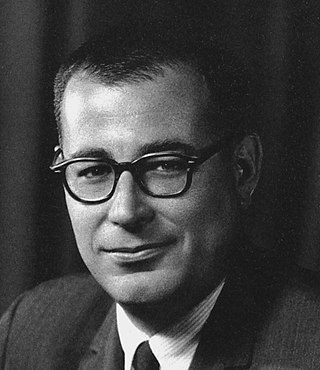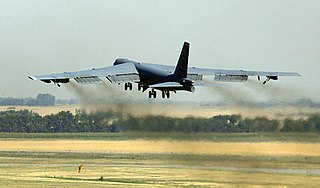
An intercontinental ballistic missile (ICBM) is a ballistic missile with a range greater than 5,500 kilometres (3,400 mi), primarily designed for nuclear weapons delivery. Conventional, chemical, and biological weapons can also be delivered with varying effectiveness, but have never been deployed on ICBMs. Most modern designs support multiple independently targetable reentry vehicle (MIRVs), allowing a single missile to carry several warheads, each of which can strike a different target. The United States, Russia, China, France, India, the United Kingdom, Israel, and North Korea are the only countries known to have operational ICBMs.

Strategic Air Command (SAC) was a United States Department of Defense Specified Command and a United States Air Force (USAF) Major Command responsible for command and control of the strategic bomber and intercontinental ballistic missile components of the United States military's strategic nuclear forces from 1946 to 1992. SAC was also responsible for the operation of strategic reconnaissance aircraft and airborne command post aircraft as well as most of the USAF's aerial refueling fleet, including aircraft from the Air Force Reserve (AFRES) and Air National Guard (ANG).

The United States Air Force (USAF) is the air service branch of the United States Armed Forces, and is one of the eight uniformed services of the United States. Originally created on 1 August 1907, as a part of the United States Army Signal Corps, the USAF was established as a separate branch of the United States Armed Forces in 1947 with the enactment of the National Security Act of 1947. It is the second youngest branch of the United States Armed Forces and the fourth in order of precedence. The United States Air Force articulates its core missions as air supremacy, global integrated intelligence, surveillance and reconnaissance, rapid global mobility, global strike, and command and control.

The LGM-30 Minuteman is an American land-based intercontinental ballistic missile (ICBM) in service with the Air Force Global Strike Command. As of 2023, the LGM-30G is the only land-based ICBM in service in the United States and represents the land leg of the U.S. nuclear triad, along with the Trident II submarine-launched ballistic missile (SLBM) and nuclear weapons carried by long-range strategic bombers.

Malmstrom Air Force Base is a United States Air Force base in Cascade County, Montana, United States, adjacent to the city of Great Falls. It was named in honor of World War II POW Colonel Einar Axel Malmstrom. It is the home of the 341st Missile Wing of the Air Force Global Strike Command (AFGSC). For statistical purposes, the United States Census Bureau has defined Malmstrom Air Force Base as a census-designated place (CDP). It had a population of 3,472 at the 2010 census.

Minot Air Force Base is a United States Air Force (USAF) installation in Ward County, North Dakota, thirteen miles (20 km) north of the city of Minot via U.S. Route 83. In the 2020 census, the base was counted as a CDP with a total population of 5,017, down from 5,521 in 2010. Minot AFB is the home of two major wings: the 5th Bomb Wing and 91st Missile Wing, both of the Air Force Global Strike Command (AFGSC).

The LGM-118 Peacekeeper, originally known as the MX for "Missile, Experimental", was a MIRV-capable intercontinental ballistic missile (ICBM) produced and deployed by the United States from 1985 to 2005. The missile could carry up to twelve Mark 21 reentry vehicles, each armed with a 300-kiloton W87 warhead. Initial plans called for building and deploying 100 MX ICBMs, but budgetary concerns limited the final procurement; only 50 entered service. Disarmament treaties signed after the Peacekeeper's development led to its withdrawal from service in 2005.

National missile defense (NMD) refers to the nationwide antimissile program the United States has had in development since the 1990s. After the renaming in 2002, the term now refers to the entire program, not just the ground-based interceptors and associated facilities.

Harold Brown was an American nuclear physicist who served as United States Secretary of Defense from 1977 to 1981, under President Jimmy Carter. Previously, in the John F. Kennedy and Lyndon B. Johnson administrations, he held the posts of Director of Defense Research and Engineering (1961–1965) and United States Secretary of the Air Force (1965–1969).
The Missile Badge is a military decoration of the United States Air Force which was first created on 23 May 1958. The "pocket rocket" badge recognizes those commissioned officers and enlisted personnel of the US Air Force who have qualified as missile personnel that have been trained in the maintenance or launching of land-based and air-launched nuclear weapons under the direction of the National Command Authority. Originally known as the Missileman Badge, the Missile Badge later became known as the Missileer Badge or more informally the Pocket Rocket and is still often referred to by this name.
The Air Force Specialty Code (AFSC) is an alphanumeric code used by the United States Air Force to identify a specific job. Officer AFSCs consist of four characters and enlisted AFSCs consist of five characters. A letter prefix or suffix may be used with an AFSC when more specific identification of position requirements and individual qualifications is necessary. The AFSC is similar to the Military Occupational Specialty Codes used by the United States Army and the United States Marine Corps or enlisted ratings and USN officer designators and Naval Officer Billet Classifications (NOBCs) used by the United States Navy and enlisted ratings and USCG officer specialties used by the United States Coast Guard. The United States Space Force equivalent is known as the Space Force Specialty Code (SFSC).

The MGM-134A Midgetman, also known as the Small Intercontinental Ballistic Missile, was an intercontinental ballistic missile developed by the United States Air Force. The system was mobile and could be set up rapidly, allowing it to move to a new firing location after learning of an enemy missile launch. To attack the weapon, the enemy would have to blanket the area around its last known location with multiple warheads, using up a large percentage of their force for limited gains and no guarantee that all of the missiles would be destroyed. In such a scenario, the U.S. would retain enough of their forces for a successful counterstrike, thereby maintaining deterrence.

Chanute Air Force Base is a decommissioned United States Air Force facility, located in Champaign County, Illinois, south of and adjacent to Rantoul, Illinois, about 130 miles (210 km) south of Chicago. Its primary mission throughout its existence was Air Force technical training. Chanute Field was established on 21 May 1917, being one of thirty-two Air Service training camps established after the United States entry into World War I.

A nuclear triad is a three-pronged military force structure of land-based intercontinental ballistic missiles (ICBMs), submarine-launched ballistic missiles (SLBMs), and strategic bombers with nuclear bombs and missiles. Countries build nuclear triads to eliminate an enemy's ability to destroy a nation's nuclear forces in a first-strike attack, which preserves their own ability to launch a second strike and therefore increases their nuclear deterrence.

On 29 August 2007, six AGM-129 ACM cruise missiles, each loaded with a W80-1 variable yield nuclear warhead, were mistakenly loaded onto a United States Air Force (USAF) B-52H heavy bomber at Minot Air Force Base in North Dakota and transported to Barksdale Air Force Base in Louisiana. The nuclear warheads in the missiles were supposed to have been removed before the missiles were taken from their storage bunker. The missiles with the nuclear warheads were not reported missing and remained mounted to the aircraft at both Minot and Barksdale for 36 hours. During this period, the warheads were not protected by the various mandatory security precautions for nuclear weapons.

The Air Force Global Strike Command (AFGSC) is a Major Command (MAJCOM) of the United States Air Force, headquartered at Barksdale Air Force Base, Louisiana. AFGSC provides combat-ready forces to conduct strategic nuclear deterrence and global strike operations in support of combatant commanders. Air Force Global Strike Command is the Air Force's service component to the United States Strategic Command (USSTRATCOM).
Conventional Prompt Strike (CPS), formerly called Prompt Global Strike (PGS), is a United States military effort to develop a system that can deliver a precision-guided conventional weapon airstrike anywhere in the world within one hour, in a similar manner to a nuclear ICBM. Such a weapon would allow the United States to respond far more swiftly to rapidly emerging threats than is possible with conventional forces. A CPS system could also be useful during a nuclear conflict, potentially replacing the use of nuclear weapons against up to 30% of targets. The CPS program encompasses numerous established and emerging technologies, including conventional surface-launched missiles and air- and submarine-launched hypersonic missiles, although no specific CPS system has yet been finalized as of 2018.

New START is a nuclear arms reduction treaty between the United States and the Russian Federation with the formal name of Measures for the Further Reduction and Limitation of Strategic Offensive Arms. It was signed on 8 April 2010 in Prague, and after ratification it entered into force on 5 February 2011.
The Nuclear Deterrence Operations Service Medal is a service medal of the United States Air Force and United States Space Force established on 27 May 2014. The medal recognizes service by personnel in various career fields who have served in units involved with national strategic nuclear deterrence operations. Officer and enlisted personnel in the Regular Air Force, Regular Space Force, Air Force Reserve, and Air National Guard communities are eligible for this medal. Eligible service is retroactive from 26 December 1991.

The LGM-35 Sentinel, also known as the Ground Based Strategic Deterrent (GBSD), is a future American land-based intercontinental ballistic missile system (ICBM) currently in the early stages of development. It is slated to replace Minuteman III missiles, currently stationed in North Dakota, Wyoming, Montana, and Nebraska from 2029 through 2075. In 2020 the Department of the Air Force awarded defense contractor Northrop Grumman a $13.3 billion sole-source contract for development of the LGM-35 after Boeing withdrew its proposal. Northrop Grumman's subcontractors on the LGM-35 include Lockheed Martin, General Dynamics, Bechtel, Honeywell, Aerojet Rocketdyne, Parsons, Textron, and others.


















